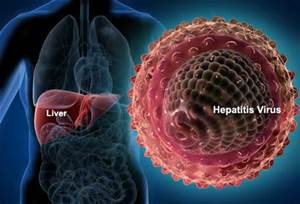
Hepatitis is a disease of the liver characterized by the presence of inflammatory cells in the tissue of the organ.
Hepatitis
Injury to the liver with inflammation of the liver cells is called hepatitis. There are five main types of hepatitis and the type is commonly determined by a laboratory test.
Liver: The liver is the largest gland in the human body. The liver is made up of thousands of lobules, each lobule consists of many hepatic cells - hepatic cells are the basic metabolic cells of the liver. It is reddish brown in color and is divided into four lobes of different sizes and lengths. It weighs approximately 3 lb (1.36 kg). Blood reaches the liver through the hepatic artery and the portal vein. The portal vein carries blood containing digested food from the small intestine, while the hepatic artery carries oxygen-rich blood from the aorta.
Types of hepatitis: There are five main types of hepatitis that are caused by a virus, A, B, C, D, and E - plus types X and G.
Hepatitis A: This is caused by eating infected food or water is infected with a virus called HAV (hepatitis A virus). Anal-oral contact during sex can also be a cause.
Hepatitis B: It is caused by the virus HBV (hepatitis B virus) and is spread by contact with infected blood, semen, and some other body fluids. This is an STD (sexually transmitted disease).
Hepatitis C: It is caused by the virus HCV (hepatitis C Virus). Hepatitis C is usually spread through direct contact with the blood of a person who has the disease. The liver can swell and become damaged. Misuse of anesthesia can result in the transmission of hepatitis B and hepatitis C viruses.
Hepatitis D: It is caused by the virus HDV (Hepatitis D Virus). Infection is through contact with infected blood, unprotected sex, and perforation of the skin with infected needles. Only a person who is already infected with hepatitis B can become infected with hepatitis D. The liver of a person with Hepatitis D swells.
Hepatitis E: A person can become infected by drinking water that contains HEV (hepatitis E virus). The liver swell but there is no long-term consequence. Infection is also possible through anal-oral sex.
Hepatitis X: Hepatitis of an unknown virus, if hepatitis cannot be attributed to the viruses of hepatitis A, B, C, D, or E, it is called hepatitis X.
Hepatitis G: This is a type of hepatitis caused by the hepatitis G virus (HGV). Usually there are they are very mild or no symptoms.
Symptoms: Fatigue, Mild fever, Diarrhea, Slight abdominal pain, Weight loss, Dark urine
Diagnosis: urine and blood analysis
Preventions:
Treatments for hepatitis:
Liver disease, alcohol, drugs